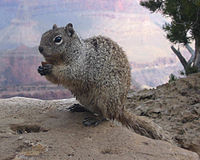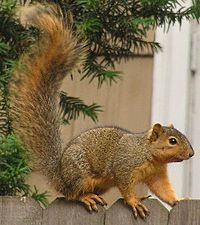Namdapha flying squirrel
| Namdapha flying squirrel | |
|---|---|

| |
| Holotype of the Namdapha flying squirrel, viewed from above and below | |
| Scientific classification | |
| Domain: | Eukaryota |
| Kingdom: | Animalia |
| Phylum: | Chordata |
| Class: | Mammalia |
| Order: | Rodentia |
| Family: | Sciuridae |
| Genus: | Biswamoyopterus |
| Species: | B. biswasi
|
| Binomial name | |
| Biswamoyopterus biswasi | |
The Namdapha flying squirrel (Biswamoyopterus biswasi) is a flying squirrel endemic to Arunachal Pradesh in northeast India, where it is known from a single zoological specimen collected in Namdapha National Park in 1981.
Description
[edit]The Namdapha flying squirrel has reddish, grizzled fur with white above and a pale grey crown; its patagium is orangish and its underparts are white. Its cheek teeth are simple, and its incisors are unpigmented. Septae are multiple in auditory bullae and sometimes honeycomb-shaped with 10 to 12 cells in it. It measures 40.5 cm (15.9 in) from head-to-vent and has a 60 cm (24 in) long tail. The hindfoot is 7.8 cm (3.1 in), and the ear is 4.6 cm (1.8 in) long.[3][4]
Taxonomy
[edit]The Namdapha flying squirrel first described in 1981, based on a single zoological specimen collected in Namdapha National Park.[2] Its scientific name commemorates Biswamoy Biswas, director of the Zoological Survey of India.[3] It was the first member of the genus Biswamoyopterus; in 2013, the Laotian giant flying squirrel (Biswamoyopterus laoensis) was described.[5] In 2018, a new flying squirrel, the Mount Gaoligong flying squirrel (Biswamoyopterus gaoligongensis) was discovered in China.[6]
Distribution and habitat
[edit]The Namdapha flying squirrel is endemic to Arunachal Pradesh in northeast India.[1] It inhabits tall Mesua ferrea jungles, often on hill slopes in the drainage basin area of Dihing River, particularly on the western slope of Patkai range in northeastern India.[3][4]
In April 2022, a putative Namdapha flying squirrel was recorded in Arunachal Pradesh.[7] To prove its validity, the researchers are planning to collect fecal samples for identification of DNA.[8]
Status
[edit]The Namdapha flying squirrel is listed as critically endangered on the IUCN Red List. Its range may be restricted to a single valley, and it is threatened by poaching of animals for food within the park, and possibly by habitat destruction.[1] It is among the 25 "most wanted lost" species that are the focus of Re:wild's "Search for Lost Species" initiative.[9]
References
[edit]- ^ a b c Molur, S. (2017) [errata version of 2016 assessment]. "Biswamoyopterus biswasi". IUCN Red List of Threatened Species. 2016: e.T2816A115063959. doi:10.2305/IUCN.UK.2016-3.RLTS.T2816A22271554.en.
- ^ a b Thorington, R.W. Jr; Hoffman, R.S. (2005). "Family Sciuridae". In Wilson, D.E.; Reeder, D.M (eds.). Mammal Species of the World: A Taxonomic and Geographic Reference (3rd ed.). Johns Hopkins University Press. pp. 754–818. ISBN 978-0-8018-8221-0. OCLC 62265494.
- ^ a b c Saha, S. S. (1981). "A new genus and a new species of flying squirrel (Mammalia: Rodentia: Sciuridae) from northeastern India" (PDF). Bulletin of the Zoological Survey of India. 4 (3): 331–336.
- ^ a b Saha, S. S. (1985). "Mammalia" (PDF). Records of the Zoological Survey of India. 82 (1–4): 321–330. doi:10.26515/rzsi/v82/i1-4/1984/161306. S2CID 251697069.
- ^ Sanamxay, D.; Douangboubpha, B.; Bumrungsri, S.; Xayavong, S.; Xayaphet, V.; Satasook, C.; Bates, P. J.J. (2013). "Rediscovery of Biswamoyopterus (Mammalia: Rodentia: Sciuridae: Pteromyini) in Asia, with the description of a new species from Lao PDR". Zootaxa. 3686 (4): 471–481. doi:10.11646/zootaxa.3686.4.5. PMID 26473234. S2CID 1381787.
- ^ Gutoskey, E. (2019). "Humongous, chihuahua-sized species of flying squirrel has been discovered in China". www.mentalfloss.com. Retrieved 21 September 2022.
- ^ Karmakar, R. (2023). "Missing for 42 years, flying squirrel resurfaces in Arunachal". The Hindu. Retrieved 23 December 2023.
- ^ Daniel, E. (2023). "This flying squirrel is still lost to science, but maybe not for much longer". Re:wild. Retrieved 29 December 2023.
- ^ "The Search for Lost Species". Global Wildlife Conservation. Retrieved 10 July 2017.




